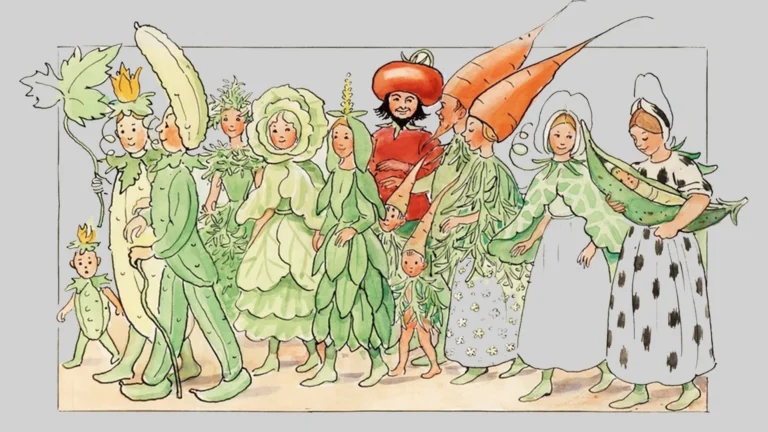Elsa Beskow (1874–1953) is a name synonymous with enchanting children’s literature and captivating illustrations. Born in Sweden, she is renowned for her whimsical storytelling and vividly imaginative artwork, which have left a lasting legacy in the realm of children’s books. This article will explore the
TRENDING
Rosey Funeral Date: Important Details And Arrangements
Early Life And Education
Childhood in Sweden
Elsa Beskow was born on February 11, 1874, in a small village near Stockholm, Sweden. Her upbringing in the serene countryside of Sweden significantly influenced her artistic style and themes. Surrounded by nature, Beskow developed a deep appreciation for the flora and fauna that would later populate her illustrations.
Artistic Education
Beskow’s artistic journey began at the Royal Academy of Fine Arts in Stockholm. There, she honed her skills in painting and illustration, allowing her innate talent to flourish. After her formal education, she traveled extensively across Europe, immersing herself in the diverse art movements of the time, including Impressionism and Art Nouveau.
The Birth Of A Literary Career
First Publications
Elsa Beskow’s first book, “Peter in Blueberry Land,” was published in 1901. This delightful tale, featuring a young boy who embarks on an adventure in a magical world of blueberries and friendly forest creatures, marked the beginning of her prolific career as a children’s author and illustrator. The book’s success was a testament to Beskow’s ability to weave enchanting narratives that appealed to both children and adults.
Unique Artistic Style
Beskow’s illustrations are characterized by their vibrant colors, intricate details, and a deep connection to nature. Her distinctive style often features children interacting with fantastical elements, such as talking animals and magical landscapes. This blend of reality and fantasy captures the imagination of young readers, making her books timeless treasures.
Notable Works
Classic Children’s Books
Elsa Beskow authored and illustrated numerous beloved children’s books throughout her career. Here are some of her most notable works:
“The Sun Egg“
Published in 1913, “The Sun Egg” tells the story of a little elf who discovers a mysterious egg in the forest. The enchanting illustrations, combined with a tale of curiosity and adventure, make this book a favorite among readers of all ages.
“Tomte Tummetot“
In 1912, Beskow released “Tomte Tummetot,” which introduced readers to the endearing gnome, Tomte. This story beautifully captures the essence of Swedish folklore and the connection between nature and humanity, featuring stunning illustrations that bring the characters and settings to life.
“The Adventures of Nils“
Beskow version of “The Adventures of Nils” (1910) is a reimagining of Selma Lagerlöf’s classic tale. This beautifully illustrated edition showcases Beskow talent for capturing the whimsical essence of Lagerlöf’s narrative while adding her unique artistic touch.
Themes in Her Work
Beskow’s stories often revolve around themes of nature, childhood innocence, and the importance of imagination. Her characters frequently embark on magical adventures, allowing young readers to explore the beauty of the natural world while instilling valuable life lessons about friendship, courage, and respect for the environment.
Impact And Legacy
Influence on Children’s Literature
Elsa Beskow’s impact on children’s literature is profound. Her ability to engage young readers with captivating stories and stunning illustrations has inspired countless authors and illustrators worldwide. Beskow’s work is often cited as a bridge between traditional fairy tales and modern children’s literature, making her an essential figure in the evolution of the genre.
Enduring Popularity
Today, Elsa Beskow’s books continue to be cherished by children and parents alike. Many of her stories have been translated into various languages, reaching a global audience. Her illustrations remain a source of inspiration for contemporary artists, and her stories are frequently adapted into theater productions, animated films, and educational programs.
Recognition and Awards
Throughout her lifetime, Beskow received numerous accolades for her contributions to literature and art. She was awarded the prestigious Bologna Children’s Book Fair Award and was recognized by various literary societies. In Sweden, her work is celebrated during the annual Elsa Beskow Day, honoring her contributions to children’s literature.
Elsa Beskow And Nature
Connection to the Environment
A defining characteristic of Beskow’s work is her profound connection to nature. Many of her stories feature lush landscapes, vibrant flora, and enchanting fauna, reflecting her belief in the importance of environmental stewardship. Beskow’s portrayal of nature encourages children to appreciate and care for the world around them.
Nature as a Character
In Beskow’s illustrations, nature is not just a backdrop; it is a character in its own right. The trees, flowers, and animals interact with the human characters, creating a magical atmosphere that immerses readers in a world of wonder. This unique approach helps instill a sense of wonder and respect for nature in young readers.
Personal Life
Marriage and Family
Elsa Beskow married fellow artist Natanael Beskow in 1900, and together they had five children. Her family life played a crucial role in her work, as she often drew inspiration from her children’s experiences and imaginations. Many of her stories are based on the adventures she had with her children in the Swedish countryside.
Later Years
In her later years, Beskow continued to create new works, although her health began to decline. Despite facing challenges, she remained committed to her craft until her passing in 1953. Her legacy endures through her timeless stories and beautiful illustrations, which continue to captivate generations of readers.
Conclusion
Elsa Beskow enchanting stories and stunning illustrations have made her an iconic figure in children’s literature. Her ability to blend fantasy with reality, coupled with her deep appreciation for nature, has left an indelible mark on the literary world. As we discover and celebrate her works, we not only honor her legacy but also inspire new generations to appreciate the magic of storytelling and the beauty of the natural world.
ALSO READ: Cumhuritey: Exploring The Essence Of The Republic
FAQs
What is Elsa Beskow best known for?
Elsa Beskow is best known for her enchanting children’s books and illustrations that combine fantasy and nature. Her most famous works include “Peter in Blueberry Land,” “Tomte Tummetot,” and “The Sun Egg.” Her art and stories have captivated readers for generations.
When was Elsa Beskow born?
Elsa Beskow was born on February 11, 1874, in a small village near Stockholm, Sweden.
How did nature influence Elsa Beskow’s work?
Nature played a significant role in Beskow’s work, as many of her stories and illustrations feature lush landscapes, vibrant flora, and enchanting fauna. She believed in the importance of environmental stewardship and often portrayed nature as a character in her stories.
Are Elsa Beskow’s books still popular today?
Yes, Elsa Beskow’s books continue to be cherished by children and parents alike. Many of her stories have been translated into various languages and are frequently adapted into theater productions, animated films, and educational programs.
What awards did Elsa Beskow receive?
Elsa Beskow received numerous accolades throughout her lifetime, including the prestigious Bologna Children’s Book Fair Award. She is celebrated in Sweden during the annual Elsa Beskow Day, honoring her contributions to children’s literature.

